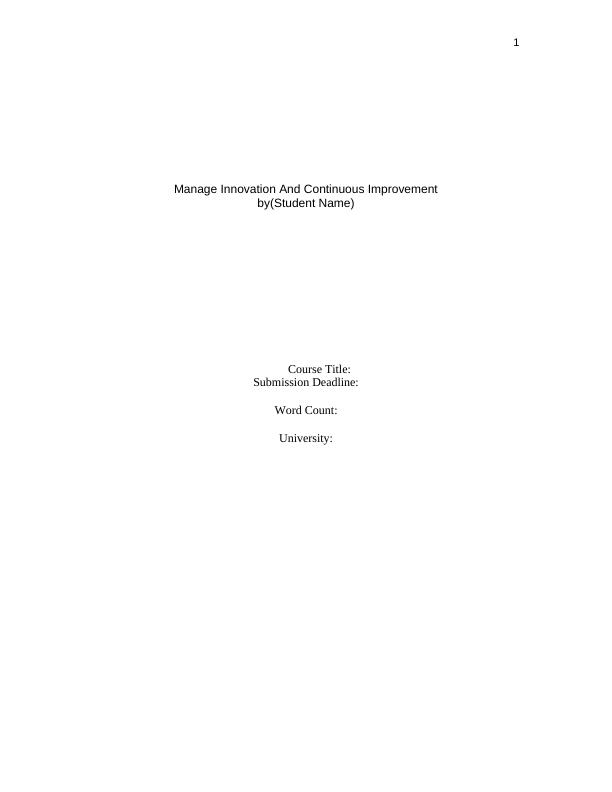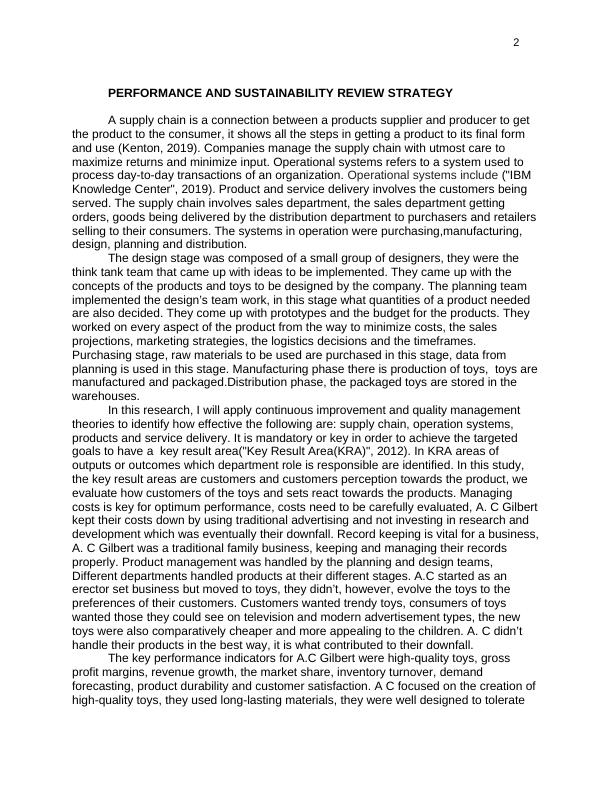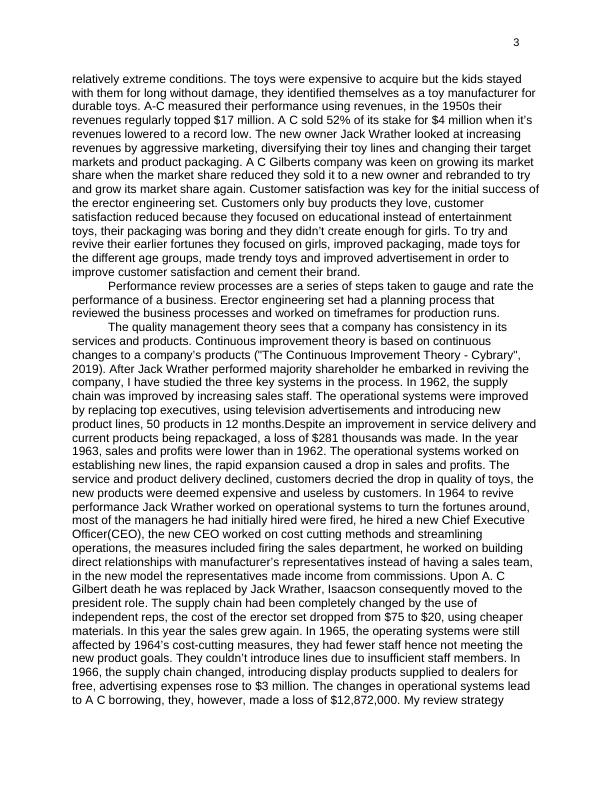Manage Innovation And Continuous Improvement
Instructions for completing the assessment for the course BSBMGT608 - Manage Innovation And Continues Improvement at Sydney Metro College.
9 Pages3438 Words14 Views
Added on 2022-09-11
Manage Innovation And Continuous Improvement
Instructions for completing the assessment for the course BSBMGT608 - Manage Innovation And Continues Improvement at Sydney Metro College.
Added on 2022-09-11
ShareRelated Documents
1
Manage Innovation And Continuous Improvement
by(Student Name)
Course Title:
Submission Deadline:
Word Count:
University:
Manage Innovation And Continuous Improvement
by(Student Name)
Course Title:
Submission Deadline:
Word Count:
University:

2
PERFORMANCE AND SUSTAINABILITY REVIEW STRATEGY
A supply chain is a connection between a products supplier and producer to get
the product to the consumer, it shows all the steps in getting a product to its final form
and use (Kenton, 2019). Companies manage the supply chain with utmost care to
maximize returns and minimize input. Operational systems refers to a system used to
process day-to-day transactions of an organization. Operational systems include ("IBM
Knowledge Center", 2019). Product and service delivery involves the customers being
served. The supply chain involves sales department, the sales department getting
orders, goods being delivered by the distribution department to purchasers and retailers
selling to their consumers. The systems in operation were purchasing,manufacturing,
design, planning and distribution.
The design stage was composed of a small group of designers, they were the
think tank team that came up with ideas to be implemented. They came up with the
concepts of the products and toys to be designed by the company. The planning team
implemented the design’s team work, in this stage what quantities of a product needed
are also decided. They come up with prototypes and the budget for the products. They
worked on every aspect of the product from the way to minimize costs, the sales
projections, marketing strategies, the logistics decisions and the timeframes.
Purchasing stage, raw materials to be used are purchased in this stage, data from
planning is used in this stage. Manufacturing phase there is production of toys, toys are
manufactured and packaged.Distribution phase, the packaged toys are stored in the
warehouses.
In this research, I will apply continuous improvement and quality management
theories to identify how effective the following are: supply chain, operation systems,
products and service delivery. It is mandatory or key in order to achieve the targeted
goals to have a key result area("Key Result Area(KRA)", 2012). In KRA areas of
outputs or outcomes which department role is responsible are identified. In this study,
the key result areas are customers and customers perception towards the product, we
evaluate how customers of the toys and sets react towards the products. Managing
costs is key for optimum performance, costs need to be carefully evaluated, A. C Gilbert
kept their costs down by using traditional advertising and not investing in research and
development which was eventually their downfall. Record keeping is vital for a business,
A. C Gilbert was a traditional family business, keeping and managing their records
properly. Product management was handled by the planning and design teams,
Different departments handled products at their different stages. A.C started as an
erector set business but moved to toys, they didn’t, however, evolve the toys to the
preferences of their customers. Customers wanted trendy toys, consumers of toys
wanted those they could see on television and modern advertisement types, the new
toys were also comparatively cheaper and more appealing to the children. A. C didn’t
handle their products in the best way, it is what contributed to their downfall.
The key performance indicators for A.C Gilbert were high-quality toys, gross
profit margins, revenue growth, the market share, inventory turnover, demand
forecasting, product durability and customer satisfaction. A C focused on the creation of
high-quality toys, they used long-lasting materials, they were well designed to tolerate
PERFORMANCE AND SUSTAINABILITY REVIEW STRATEGY
A supply chain is a connection between a products supplier and producer to get
the product to the consumer, it shows all the steps in getting a product to its final form
and use (Kenton, 2019). Companies manage the supply chain with utmost care to
maximize returns and minimize input. Operational systems refers to a system used to
process day-to-day transactions of an organization. Operational systems include ("IBM
Knowledge Center", 2019). Product and service delivery involves the customers being
served. The supply chain involves sales department, the sales department getting
orders, goods being delivered by the distribution department to purchasers and retailers
selling to their consumers. The systems in operation were purchasing,manufacturing,
design, planning and distribution.
The design stage was composed of a small group of designers, they were the
think tank team that came up with ideas to be implemented. They came up with the
concepts of the products and toys to be designed by the company. The planning team
implemented the design’s team work, in this stage what quantities of a product needed
are also decided. They come up with prototypes and the budget for the products. They
worked on every aspect of the product from the way to minimize costs, the sales
projections, marketing strategies, the logistics decisions and the timeframes.
Purchasing stage, raw materials to be used are purchased in this stage, data from
planning is used in this stage. Manufacturing phase there is production of toys, toys are
manufactured and packaged.Distribution phase, the packaged toys are stored in the
warehouses.
In this research, I will apply continuous improvement and quality management
theories to identify how effective the following are: supply chain, operation systems,
products and service delivery. It is mandatory or key in order to achieve the targeted
goals to have a key result area("Key Result Area(KRA)", 2012). In KRA areas of
outputs or outcomes which department role is responsible are identified. In this study,
the key result areas are customers and customers perception towards the product, we
evaluate how customers of the toys and sets react towards the products. Managing
costs is key for optimum performance, costs need to be carefully evaluated, A. C Gilbert
kept their costs down by using traditional advertising and not investing in research and
development which was eventually their downfall. Record keeping is vital for a business,
A. C Gilbert was a traditional family business, keeping and managing their records
properly. Product management was handled by the planning and design teams,
Different departments handled products at their different stages. A.C started as an
erector set business but moved to toys, they didn’t, however, evolve the toys to the
preferences of their customers. Customers wanted trendy toys, consumers of toys
wanted those they could see on television and modern advertisement types, the new
toys were also comparatively cheaper and more appealing to the children. A. C didn’t
handle their products in the best way, it is what contributed to their downfall.
The key performance indicators for A.C Gilbert were high-quality toys, gross
profit margins, revenue growth, the market share, inventory turnover, demand
forecasting, product durability and customer satisfaction. A C focused on the creation of
high-quality toys, they used long-lasting materials, they were well designed to tolerate

3
relatively extreme conditions. The toys were expensive to acquire but the kids stayed
with them for long without damage, they identified themselves as a toy manufacturer for
durable toys. A-C measured their performance using revenues, in the 1950s their
revenues regularly topped $17 million. A C sold 52% of its stake for $4 million when it’s
revenues lowered to a record low. The new owner Jack Wrather looked at increasing
revenues by aggressive marketing, diversifying their toy lines and changing their target
markets and product packaging. A C Gilberts company was keen on growing its market
share when the market share reduced they sold it to a new owner and rebranded to try
and grow its market share again. Customer satisfaction was key for the initial success of
the erector engineering set. Customers only buy products they love, customer
satisfaction reduced because they focused on educational instead of entertainment
toys, their packaging was boring and they didn’t create enough for girls. To try and
revive their earlier fortunes they focused on girls, improved packaging, made toys for
the different age groups, made trendy toys and improved advertisement in order to
improve customer satisfaction and cement their brand.
Performance review processes are a series of steps taken to gauge and rate the
performance of a business. Erector engineering set had a planning process that
reviewed the business processes and worked on timeframes for production runs.
The quality management theory sees that a company has consistency in its
services and products. Continuous improvement theory is based on continuous
changes to a company’s products ("The Continuous Improvement Theory - Cybrary",
2019). After Jack Wrather performed majority shareholder he embarked in reviving the
company, I have studied the three key systems in the process. In 1962, the supply
chain was improved by increasing sales staff. The operational systems were improved
by replacing top executives, using television advertisements and introducing new
product lines, 50 products in 12 months.Despite an improvement in service delivery and
current products being repackaged, a loss of $281 thousands was made. In the year
1963, sales and profits were lower than in 1962. The operational systems worked on
establishing new lines, the rapid expansion caused a drop in sales and profits. The
service and product delivery declined, customers decried the drop in quality of toys, the
new products were deemed expensive and useless by customers. In 1964 to revive
performance Jack Wrather worked on operational systems to turn the fortunes around,
most of the managers he had initially hired were fired, he hired a new Chief Executive
Officer(CEO), the new CEO worked on cost cutting methods and streamlining
operations, the measures included firing the sales department, he worked on building
direct relationships with manufacturer’s representatives instead of having a sales team,
in the new model the representatives made income from commissions. Upon A. C
Gilbert death he was replaced by Jack Wrather, Isaacson consequently moved to the
president role. The supply chain had been completely changed by the use of
independent reps, the cost of the erector set dropped from $75 to $20, using cheaper
materials. In this year the sales grew again. In 1965, the operating systems were still
affected by 1964’s cost-cutting measures, they had fewer staff hence not meeting the
new product goals. They couldn’t introduce lines due to insufficient staff members. In
1966, the supply chain changed, introducing display products supplied to dealers for
free, advertising expenses rose to $3 million. The changes in operational systems lead
to A C borrowing, they, however, made a loss of $12,872,000. My review strategy
relatively extreme conditions. The toys were expensive to acquire but the kids stayed
with them for long without damage, they identified themselves as a toy manufacturer for
durable toys. A-C measured their performance using revenues, in the 1950s their
revenues regularly topped $17 million. A C sold 52% of its stake for $4 million when it’s
revenues lowered to a record low. The new owner Jack Wrather looked at increasing
revenues by aggressive marketing, diversifying their toy lines and changing their target
markets and product packaging. A C Gilberts company was keen on growing its market
share when the market share reduced they sold it to a new owner and rebranded to try
and grow its market share again. Customer satisfaction was key for the initial success of
the erector engineering set. Customers only buy products they love, customer
satisfaction reduced because they focused on educational instead of entertainment
toys, their packaging was boring and they didn’t create enough for girls. To try and
revive their earlier fortunes they focused on girls, improved packaging, made toys for
the different age groups, made trendy toys and improved advertisement in order to
improve customer satisfaction and cement their brand.
Performance review processes are a series of steps taken to gauge and rate the
performance of a business. Erector engineering set had a planning process that
reviewed the business processes and worked on timeframes for production runs.
The quality management theory sees that a company has consistency in its
services and products. Continuous improvement theory is based on continuous
changes to a company’s products ("The Continuous Improvement Theory - Cybrary",
2019). After Jack Wrather performed majority shareholder he embarked in reviving the
company, I have studied the three key systems in the process. In 1962, the supply
chain was improved by increasing sales staff. The operational systems were improved
by replacing top executives, using television advertisements and introducing new
product lines, 50 products in 12 months.Despite an improvement in service delivery and
current products being repackaged, a loss of $281 thousands was made. In the year
1963, sales and profits were lower than in 1962. The operational systems worked on
establishing new lines, the rapid expansion caused a drop in sales and profits. The
service and product delivery declined, customers decried the drop in quality of toys, the
new products were deemed expensive and useless by customers. In 1964 to revive
performance Jack Wrather worked on operational systems to turn the fortunes around,
most of the managers he had initially hired were fired, he hired a new Chief Executive
Officer(CEO), the new CEO worked on cost cutting methods and streamlining
operations, the measures included firing the sales department, he worked on building
direct relationships with manufacturer’s representatives instead of having a sales team,
in the new model the representatives made income from commissions. Upon A. C
Gilbert death he was replaced by Jack Wrather, Isaacson consequently moved to the
president role. The supply chain had been completely changed by the use of
independent reps, the cost of the erector set dropped from $75 to $20, using cheaper
materials. In this year the sales grew again. In 1965, the operating systems were still
affected by 1964’s cost-cutting measures, they had fewer staff hence not meeting the
new product goals. They couldn’t introduce lines due to insufficient staff members. In
1966, the supply chain changed, introducing display products supplied to dealers for
free, advertising expenses rose to $3 million. The changes in operational systems lead
to A C borrowing, they, however, made a loss of $12,872,000. My review strategy

End of preview
Want to access all the pages? Upload your documents or become a member.
Related Documents
Continous Improvement of the AC Gilbert Laboratorylg...
|9
|1206
|474
Programs, Systems and Processes Assignmentlg...
|19
|3927
|43
BSBMGT608 - Manage Innovation and Continuous Improvementlg...
|13
|2792
|229
Systems and Processes Assignmentlg...
|22
|1342
|71
Advance Diploma Leadership and Management: Key Processes, Strategies, and Improvementslg...
|18
|4106
|159
BSBMGT608 Manage Innovation And Continuous Improvement Assignmentlg...
|20
|4531
|47
